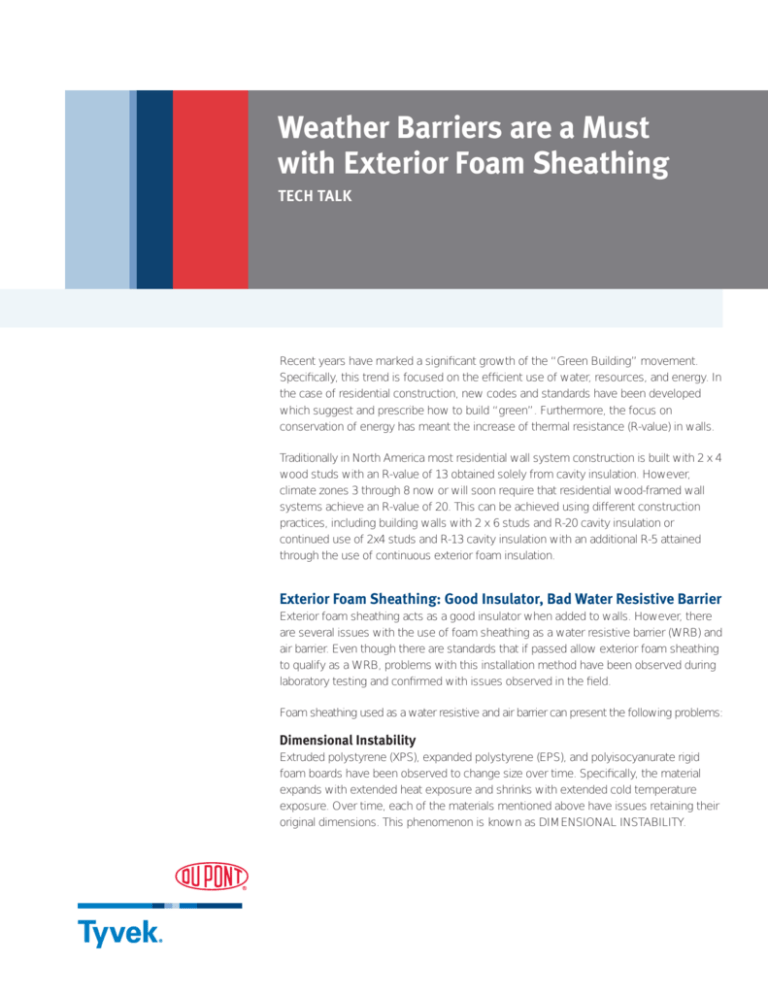
Weather Barriers are a Must
with Exterior Foam Sheathing
TECH TALK
Recent years have marked a significant growth of the “Green Building” movement.
Specifically, this trend is focused on the efficient use of water, resources, and energy. In
the case of residential construction, new codes and standards have been developed
which suggest and prescribe how to build “green”. Furthermore, the focus on
conservation of energy has meant the increase of thermal resistance (R-value) in walls.
Traditionally in North America most residential wall system construction is built with 2 x 4
wood studs with an R-value of 13 obtained solely from cavity insulation. However,
climate zones 3 through 8 now or will soon require that residential wood-framed wall
systems achieve an R-value of 20. This can be achieved using different construction
practices, including building walls with 2 x 6 studs and R-20 cavity insulation or
continued use of 2x4 studs and R-13 cavity insulation with an additional R-5 attained
through the use of continuous exterior foam insulation.
Exterior Foam Sheathing: Good Insulator, Bad Water Resistive Barrier
Exterior foam sheathing acts as a good insulator when added to walls. However, there
are several issues with the use of foam sheathing as a water resistive barrier (WRB) and
air barrier. Even though there are standards that if passed allow exterior foam sheathing
to qualify as a WRB, problems with this installation method have been observed during
laboratory testing and confirmed with issues observed in the field.
Foam sheathing used as a water resistive and air barrier can present the following problems:
Dimensional Instability
Extruded polystyrene (XPS), expanded polystyrene (EPS), and polyisocyanurate rigid
foam boards have been observed to change size over time. Specifically, the material
expands with extended heat exposure and shrinks with extended cold temperature
exposure. Over time, each of the materials mentioned above have issues retaining their
original dimensions. This phenomenon is known as DIMENSIONAL INSTABILITY.
”
94
”
“XPS and polyisocyanurate have commonly been utilized as
a moisture barrier, but recent building science research has
shown that these products may not be as dimensionally
stable as initially thought. There is some evidence that the
insulation boards shrink enough (up to 5/8”) that simply
taping the joints may not be sufficient to maintain the
drainage plane long term.”
Energy Efficient and Green Technology Building Template Guide for
the State of Maryland, prepared for Maryland Energy Administration
– Energy Efficiency Programs by Steven Winter Associates,
January 10, 2007
This statement has been supported in recent laboratory aging
studies which were performed in accordance with the Thermal
Aging criteria described in AAMA 711-07 (2007 Voluntary
Specification for Self Adhering Flashing Used for Installation of
Exterior Wall Fenestration Products), which simulates long term
exposure to the elements.
”
=
47
+
48
This increases the chances of mold growth, wood rot, and
several other issues which will ultimately affect the structural
integrity and performance of the wall system. Below is an
observation by a third party:
Figure II: A Practical Example of Foam Shrinkage
96
XPS, EPS, and polyisocyanurate foam boards are typically
installed in residential construction with butt joints which are
then taped. As the XPS, EPS, and polyisocyanurate boards
expand and contract over time, each of these materials has
issues retaining their original dimensions. This means that the
taped butt joint begins to be taxed which can cause the seam
to fail. When a taped seam fails, water and air are allowed to
easily penetrate into the wall cavity.
Furthermore, ASTM standard specifications C578, C591, and
C1289 have thresholds of 1 to 4% expansion or contraction
measured by Standard D-2126: Standard Test Method for
Response of Rigid Cellular Plastics to Thermal and Humid Aging,
before foam boards are deemed dimensionally unstable. In
order to visualize what this means, consider a 2% dimensional
change in a 4’ x 8’ sheet of foam sheathing subject to cold
temperature as referenced in Figure II below.
”
Dimensional Instability – What does this mean for
the wall system?
2%
Shrinkage
This means that seams which were butt joints, can retract
anywhere from 1” – 2”. This retraction strains the tape and
allows for water and air to move freely through the wall.
Poor Water Management
Another issue with the use of foam as a water resistive barrier
is POOR WATER MANAGEMENT. This occurs with taped
insulating sheathing panels because of the continual occurrence
of reverse shingling at horizontal tape joints. Specifically, taped
foam joints have an inherent issue known as reverse shingling.
Unlike products such as Tyvek HomeWrap , taped foam joints
cannot be lapped in order to properly shed water. Water can
enter into the top of the taped seam and continue into the wall
system, resulting in significant moisture-intrusion issues.
See Figure III.
®
®
Figure I: Polyisocyanurate, 70°C Thermal Exposure
Figure III: Traditional versus Reverse Shingling
Traditional Shingling:
Tyvek® HomeWrap®
with Lap
Taped Traditional
Shingling:
Tyvek® HomeWrap®
with Taped Lap
ek
ap
ek
ap
®
®
Figure I demonstrates (via buckling) how extended periods of
heat exposure results in expansion of the foam board which
places stress on the taped joints.
Du
P
T
®
®
Du
P
T
Taped Sheathing
Joints:
Taped XPS, EPS,
or Polyiso
The issue highlighted in Figure III was also observed during
laboratory experiments, where a wall was sheathed with foam.
Butt joints were created and then taped. Water entered in
through the top edge (i.e. the reverse shingle) of the tape and
then went into the wall cavity. See Figure IV.
Figure IV: Laboratory Wall Test of Taped Foam Sheathing
intrinsic with foam products can be remedied by using a wrap
product as the water resistive barrier and to provide continuity at
air barrier details. The use of DuPont Tyvek Weatherization
system products in conjunction with exterior continuous
insulation, provides both higher R-value walls and a more
durable and superior water resistive and air barrier.
™
®
DuPont Tyvek wraps can be installed UNDER or OVER exterior
foam insulation. The DuPont Tyvek wrap should be installed on
the same plane as the window flanges to allow for the most
effective installation. DuPont does not recommend taping the
foam seams regardless of whether the Tyvek is installed under
or over the foam. Not taping the seams will have very little
effect on the foam R-value, and because of the low permeability
of the foam, the open seams will help the wall breathe.
™
®
™
®
®
When a DuPont Tyvek wrap is installed UNDER exterior foam
insulation, it’s recommended that DuPont Tyvek DrainWrap ,
StuccoWrap , or CommercialWrap D be used for enhanced
drainage. DuPont Tyvek DrainWrap , StuccoWrap , or
CommercialWrap D are creped, mechanically fastened wrap
products developed for enhanced drainage. DuPont Tyvek
DrainWrap , StuccoWrap , or CommercialWrap D are water
resistive barriers with long established dimensional stability.
Additionally, these water resistive barriers can be easily installed
with the proper shingling, thus providing the correct water
shedding properties. For these reasons, foam should be paired
with DuPont Tyvek DrainWrap , StuccoWrap , or
CommercialWrap D when the foam is installed over the Tyvek
wrap. See Figure V below for an example of DuPont Tyvek
DrainWrap installed UNDER exterior foam insulation.
™
®
™
®
Red shows water
intrusion behind tape
seam - Result of
reverse shingling
®
™
®
™
®
™
®
®
™
™
®
™
®
®
®
™
®
®
Red col
colored water
trapped behind tape seam
®
™
®
™
From these observations, it can be concluded that insulating
sheathing, such as foam panels, cannot be used as a reliable
water resistive barrier or drainage plane.
Figure V: DuPont Tyvek DrainWrap Under Foam Sheathing
™
Other issues with using foam sheathing as a water resistive
barrier or air barrier arise when flashing windows and other
penetrations. The 2009 IRC states, “Approved corrosionresistant flashing shall be applied shingle-fashion in a manner to
prevent entry of water into the wall cavity or penetration of
water to the building structural framing components.” Foam
sheathing, because of its thickness, however, creates a
“reverse shingle” at the head of the window. These details will
be entirely dependent on the quality of the adhesion of the tape
or self-adhered flashing to the surface of the panel material. The
ability to maintain continuity at these details is also subject to
issues relating to dimensional stability of the foam sheathing.
®
Photo courtesy of Cold Climate Housing Research Center
When a DuPont Tyvek wrap is installed OVER exterior foam
insulation, DuPont Tyvek HomeWrap can be used for the
application. Additionally, DuPont Tyvek DrainWrap , StuccoWrap ,
or CommercialWrap D could also be used in place of the Tyvek
HomeWrap for this application if enhanced drainage is desired. All
of these products are water resistive barriers with long established
dimensional stability, and can be easily installed with the proper
shingling to provide the correct water shedding properties.
™
®
™
The Solution: DuPont Tyvek HomeWrap , Tyvek
DrainWrap , StuccoWrap , or CommercialWrap D
™
®
®
®
®
®
®
Laboratory experiments and field observations point out foam
sheathing is a good insulator, but a poor water resistive and air
barrier. The dimensional stability and water management issues
™
®
®
™
®
®
®
™
®
®
DuPont Tyvek Specialist Network
Complete system of products
A national group of highly trained field representatives is
available to assist you with your installations. From the latest
updates on building codes, to keeping up with current trends
and challenges, your local DuPont Tyvek Specialist can provide
on-site consulting and training to help make sure the job gets
done right.
For optimal protection on all your building projects, use the
complete line of DuPont Weatherization Systems products:
™
®
™
®
™
DuPont
DuPont
DuPont
DuPont
DuPont
DuPont
DuPont
DuPont
DuPont
DuPont
DuPont
DuPont
™
™
™
™
™
™
Limited Warranty
™
DuPont Tyvek Weatherization Systems products are backed by
a limited warranty. To learn more about the system that’s right
for you and to contact a DuPont Tyvek Specialist in your area,
visit www.construction.tyvek.com or call 1-800-44-Tyvek.
™
®
™
®
™
™
™
™
™
Tyvek HomeWrap
Tyvek StuccoWrap
Tyvek DrainWrap
Tyvek ThermaWrap
RoofLiner
FlexWrap NF
StraightFlash
StraightFlash VF
Flashing Tape
Tyvek Tape
Residential Sealant
Tyvek Wrap Caps
®
®
®
®
®
™
®
™
™
™
™
®
®
DuPont Tyvek Certified Installers
™
®
The DuPont Certified Installer Program is one more way to put
the building science expertise of DuPont right at your fingertips.
Your DuPont Tyvek Certified installer provides trained
installation services to help seal the building envelope.
™
™
®
To locate a certified installer in your area, please visit
www.construction.tyvek.com.
For more information, please visit
www.Construction.Tyvek.com
or call 1-800-44-Tyvek
Copyright © 2011 DuPont. The DuPont Oval Logo, DuPont™, The miracles of science™, DrainWrap™, FlexWrap™, HomeWrap®, StraightFlash®, StuccoWrap®, ThermaWrap™, and Tyvek™, are trademarks or registered
trademarks of E.I. du Pont de Nemours and company or its affiliates. All rights reserved. K-25107 5/11








